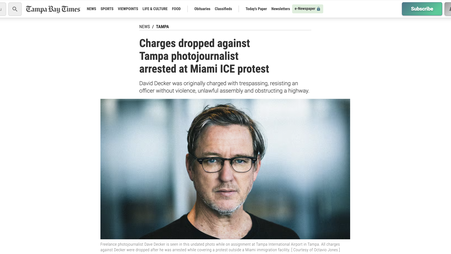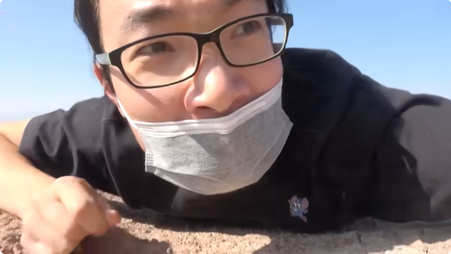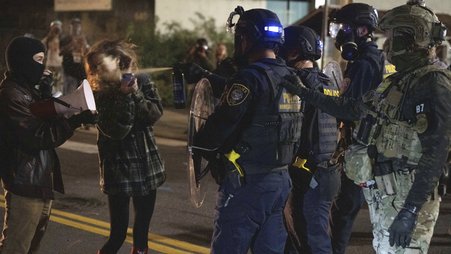
Police reportedly teargassed journalists and activists at a protest earlier this month against the police training facility known as Cop City. Then reporters were told the area was a "crime scene," and they'd be arrested if they returned. "Cop City" by Chad Davis. is licensed under CC BY 2.0.
Protests are newsworthy. Police arresting and assaulting protesters is newsworthy. Journalists should be able to safely report on both protests and their aftermath.
None of that seems particularly controversial, especially when police departments nationwide are forced to pay large sums to settle claims arising from their illegal treatment of journalists covering protests after George Floyd’s murder. You’d think cops would learn their lesson.
Yet, law enforcement officials across the country continue to harass journalists as they attempt to document demonstrations, despite their posing no risk to police operations or public safety. Too often, authorities face no consequences for their actions.
The latest examples come from Washington, D.C., and Atlanta, Georgia. Unfortunately, neither case is receiving the kind of national attention that is needed to foster accountability or dissuade similar conduct going forward.
Muzzled at the museum
Freelance journalist Will Allen-DuPraw was assigned to film protesters handing out flyers encouraging patrons at Washington’s National Gallery of Art to call on President Joe Biden to declare a climate emergency. This wasn’t some out-of-control riot — there were two protesters. After one was arrested for refusing orders to leave the museum, Allen-DuPraw asked him for comment. Then a security guard blocked Allen-DuPraw’s camera and handcuffed him as well.
Allen-DuPraw was later released without charges, but he should’ve never been detained in the first place, especially at a museum run by the federal government. Says who? Says the federal government. A recent Department of Justice report on the Minneapolis Police Department’s response to Black Lives Matter protests says the following:
“The First Amendment requires that any restrictions on when, where, and how reporters gather information ‘leave open ample alternative channels’ for gathering the news. Blanket enforcement of dispersal orders and curfews against press violates this principle because they foreclose the press from reporting about what happens after the dispersal or curfew is issued, including how police enforce those orders.”
Federal appellate courts have said the same, although, prior to the Minneapolis report, the DOJ disagreed.
Allen-Dupraw wasn’t even ordered to disperse — nor could he have (lawfully) been, given that he was causing no disturbance whatsoever. But the detainment unlawfully prevented him from exercising his constitutional right to report on the protesters’ arrests. He can sue to vindicate his own rights, and safeguard those of future journalists, if he chooses. But the public can never get back the news it missed out on.
It’s great that the DOJ has reversed its prior position and acknowledged the First Amendment freedoms of journalists covering protests. But if it only says so on page 52 of a report, unlikely to be read by people without a specific interest in the Minneapolis Police Department, what does that accomplish?
The DOJ needs to make clear to federal agencies and officials, including those working security at federal buildings, that the First Amendment requires them to allow journalists to report on protests and their fallout, and that the DOJ will not defend their actions if they don’t.
Cop City ‘crime scene’ con
At the same time, the protests against the Atlanta police training facility commonly known as “Cop City” continue to prompt outrageous First Amendment violations.
While the unprecedented anti-racketeering case against activists and protesters has rightfully received the lion’s share of attention lately, the press certainly has not been spared from authorities’ unconstitutional crackdown on dissent.
When police tear-gassed a protest against “Cop City” earlier this month, journalists and others on the scene said cops appeared to deliberately target the press with the first canister. If that’s correct it’s reprehensible and the journalists who were targeted absolutely should sue.
But police didn’t stop there. When reporters attempted to reenter the area where the protest occurred, gas-masked officers told them they couldn’t, and ordered them to disperse or be arrested because the area was a “crime scene.”
To the best of our knowledge, police were not attempting to, for example, preserve evidence as part of an investigation into any particular crime. They just called the entire area a crime scene, presumably based on claims that protesters had trespassed or gotten out of hand.
Even before the DOJ opined that dispersing journalists along with protesters is unconstitutional, authorities were required by the First Amendment to exclude journalists from public spaces only pursuant to reasonable “time, place, and manner” restrictions.
That means exclusions must be necessary, as narrow as possible, and leave journalists viable options to observe and report from elsewhere.
Cops can’t use “crime scene” as magic words to get around those well-established constitutional principles and evade media scrutiny. And when they try that or other illegal ploys to circumvent the Constitution, journalists and everyone who values the First Amendment should loudly and publicly call them out.
Update: Responding to harassment of journalists at protests can sometimes feel like a game of whack-a-mole. Immediately after publishing this article we learned that sheriffs in Arizona this morning arrested NPR reporter Alisa Reznick as she walked back to her car from covering a protest against the Israel-Gaza war. They said she didn’t leave quickly enough but the First Amendment says she shouldn’t have to leave at all.




